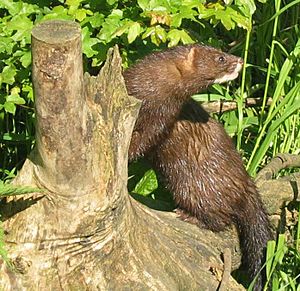European mink facts for kids
Quick facts for kids European mink |
|
|---|---|
 |
|
| Conservation status | |
| Scientific classification | |
| Genus: |
Mustela
|
| Species: |
lutreola
|
 |
|
| European mink range (brown – extant, red – introduced, orange – possibly extinct) |
|
| Synonyms | |
|
Viverra lutreola Linnaeus, 1761 |
|
The European mink (Mustela lutreola) is a small, furry animal that lives near water. It is a type of mustelid, which is a family of animals that includes weasels and otters. People sometimes call it the Russian mink or Eurasian mink. It originally comes from Europe.
Contents
What the European Mink Looks Like
The European mink has a long, thin body with short legs. It has a wide head and small ears. Its tail is also quite short.
- Male minks are usually about 37 to 43 centimeters (14.7 to 16.9 inches) long.
- Female minks are a bit smaller, around 35 to 40 centimeters (13.9 to 15.7 inches) long.
- Their tails are about 15 to 19 centimeters (6 to 7.5 inches) long.
- These minks weigh between 550 and 800 grams (1.2 to 1.7 pounds).
European minks are very fast and quick animals. They are also excellent swimmers. They can even run along the bottom of streams and stay underwater for a minute or two!
Their Fur Coat
The European mink's fur changes with the seasons.
- In winter, their fur is very thick and soft. It keeps them warm.
- In summer, their fur is a bit shorter and less dense.
Their fur color can be different shades of brown. Some minks are dark brown, almost blackish-brown. Others are a lighter reddish-brown.
Where European Minks Live
European minks can be found in parts of Northeast Spain and France. They also live across Europe all the way to the Irtysh and Ob Rivers in Russia.
They prefer to live near fresh water, like creeks, rivers, and lakes. They like places where the banks are covered with lots of plants and trees. European minks might dig their own burrows to live in. They might also use burrows made by other animals, like water voles. Sometimes, they even live in cracks between the roots of trees.
What European Minks Eat
The European mink eats different animals that live in or near water.
- Voles are a very important part of their diet.
- They also eat crustaceans (like crayfish), frogs, and water insects.
- In areas with floodlands, fish become a major food source for them.
When there is a lot of food available, European minks will often store some of it for later.
European Mink Life Cycle and Reproduction
The mating season for European minks happens from February to March. After mating, the mother mink is pregnant for about 35 to 72 days.
- Baby minks, called kits, are born in April and May.
- A mother mink usually gives birth to three to seven kits at a time.
- When they are born, kits are very small, weighing only about 6.5 grams (0.23 ounces).
- They are born blind, and their eyes open after about 30 to 31 days.
- Kits drink their mother's milk for about two to two and a half months.
- They start eating solid food when they are about 20 to 25 days old.
- By the time they are 56 to 70 days old, they follow their mother to learn how to hunt.
- They leave their family and go out on their own when they are about 70 to 84 days old.
Why European Minks Need Our Help
Sadly, the number of European minks has been going down a lot. Because of this, they are now listed as critically endangered by the IUCN (International Union for Conservation of Nature). This means they are at a very high risk of becoming extinct in the wild.
There are a few main reasons why their numbers are dropping:
- Hunting for fur: In the past, many minks were caught for their valuable fur.
- Water pollution: Pollution in rivers and lakes harms the mink's food sources and their habitat.
- Hydroelectric dams: These dams can change the flow of rivers and destroy the places where minks live and hunt.
People are trying to help the European mink. There have been efforts to bring them back to places like the Kuril Islands and Tajikistan.
Images for kids
See also
 In Spanish: Visón europeo para niños
In Spanish: Visón europeo para niños







